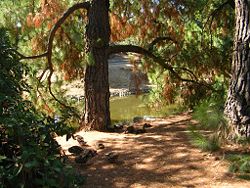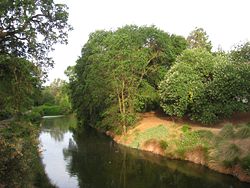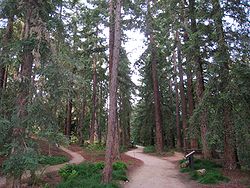
University of California, Davis, Arboretum
Encyclopedia



Arboretum
An arboretum in a narrow sense is a collection of trees only. Related collections include a fruticetum , and a viticetum, a collection of vines. More commonly, today, an arboretum is a botanical garden containing living collections of woody plants intended at least partly for scientific study...
along the banks of Putah Creek
Putah Creek
Putah Creek is a major stream in Northern California, a tributary of the Yolo Bypass. The creek has its headwaters in the Mayacamas Mountains, a part of the Coast Range...
, at the south side of the University of California, Davis
University of California, Davis
The University of California, Davis is a public teaching and research university established in 1905 and located in Davis, California, USA. Spanning over , the campus is the largest within the University of California system and third largest by enrollment...
campus in Davis, California
Davis, California
Davis is a city in Yolo County, California, United States. It is part of the Sacramento–Arden-Arcade–Roseville Metropolitan Statistical Area...
, USA
United States
The United States of America is a federal constitutional republic comprising fifty states and a federal district...
. It is open during daylight hours with free admission.
Established in 1936, the Arboretum contains 3.5 miles (5.6 km) of paved paths and more than 4,000 varieties of plants and trees adapted to the Mediterranean climate, cool, wet winters and hot dry summer, typical of much of California. Temperatures in Davis range from 14 to 118 °F (-10 to 48 °C), and average rainfall is only 19 inches (483 mm) per year.
Plants in the Arboretum are arranged in gardens that represent different geographic areas, plant groups, horticultural themes, or historical periods:
- The Arboretum Terrace is a demonstration garden for California's Central Valley.
- The Mary Wattis Brown Garden of California Native Plants includes drought-tolerant species suitable for landscape plantings as well as a number of rare and endangered plants. It showcases California wild lilac (CeanothusCeanothusCeanothus L. is a genus of about 50–60 species of shrubs or small trees in the buckthorn family Rhamnaceae. The genus is confined to North America, the center of its distribution in California, with some species in the eastern United States and southeast Canada, and others extending as far south...
) and a planting of native bunchgrasses.
- The Ruth Risdon Storer Garden features flowering perennials and small shrubs suited to central valley gardens.
- The Carolee Shields White Flower Garden is a theme garden based on medieval moon-viewing gardens of India and Japan. With its curving paths framing a vine-covered gazebo, the garden is a popular site for weddings and other events. Many of the plants here are fragrant, and their pale flowers are particularly luminous by moonlight.
- More than 80 kinds of oakOakAn oak is a tree or shrub in the genus Quercus , of which about 600 species exist. "Oak" may also appear in the names of species in related genera, notably Lithocarpus...
s are collected in the Peter J. Shields Oak Grove, including a fine collection of oaks native to the western United States. Other important collections include conifers and acaciaAcaciaAcacia is a genus of shrubs and trees belonging to the subfamily Mimosoideae of the family Fabaceae, first described in Africa by the Swedish botanist Carl Linnaeus in 1773. Many non-Australian species tend to be thorny, whereas the majority of Australian acacias are not...
s.
- The Mediterranean Collection features plants native to the Mediterranean basin, arrayed around a scenic lagoon. This section is noted for its collection of medicinal and culinary herbs. It also features plants from South AfricaSouth AfricaThe Republic of South Africa is a country in southern Africa. Located at the southern tip of Africa, it is divided into nine provinces, with of coastline on the Atlantic and Indian oceans...
, AustraliaAustraliaAustralia , officially the Commonwealth of Australia, is a country in the Southern Hemisphere comprising the mainland of the Australian continent, the island of Tasmania, and numerous smaller islands in the Indian and Pacific Oceans. It is the world's sixth-largest country by total area...
, the Southwestern United States, MexicoMexicoThe United Mexican States , commonly known as Mexico , is a federal constitutional republic in North America. It is bordered on the north by the United States; on the south and west by the Pacific Ocean; on the southeast by Guatemala, Belize, and the Caribbean Sea; and on the east by the Gulf of...
, and ChileChileChile ,officially the Republic of Chile , is a country in South America occupying a long, narrow coastal strip between the Andes mountains to the east and the Pacific Ocean to the west. It borders Peru to the north, Bolivia to the northeast, Argentina to the east, and the Drake Passage in the far...
.
- The Redwood Memorial Grove is one of the largest collections of Sequoia sempervirens, the coast redwood, outside its native range. Other native plants, including several 200-year-old Valley oaks (Quercus lobata), are found in the California Foothill Collection.
- The Desert Collection features cactiCactusA cactus is a member of the plant family Cactaceae. Their distinctive appearance is a result of adaptations to conserve water in dry and/or hot environments. In most species, the stem has evolved to become photosynthetic and succulent, while the leaves have evolved into spines...
and succulents as well fan palmArecaceaeArecaceae or Palmae , are a family of flowering plants, the only family in the monocot order Arecales. There are roughly 202 currently known genera with around 2600 species, most of which are restricted to tropical, subtropical, and warm temperate climates...
s, mesquiteMesquiteMesquite is a leguminous plant of the Prosopis genus found in northern Mexico through the Sonoran Desert and Chihuahuan Deserts, and up into the Southwestern United States as far north as southern Kansas, west to the Colorado Desert in California,and east to the eastern fifth of Texas, where...
s, and other desert trees and shrubs.
- The Early California Garden represents a garden from the rancho period, roughly 1840-1860, when California was part of Mexico and plants from Europe, Asia, and Central America were introduced into Californian gardens.
See also
- List of botanical gardens in the United States
- California native plantsCalifornia native plantsCalifornia native plants are plants that existed in California prior to the arrival of European explorers and colonists in the late 18th century...
External links
- UC Davis Arboretum website
- UC Davis Arboretum on the Davis Wiki

